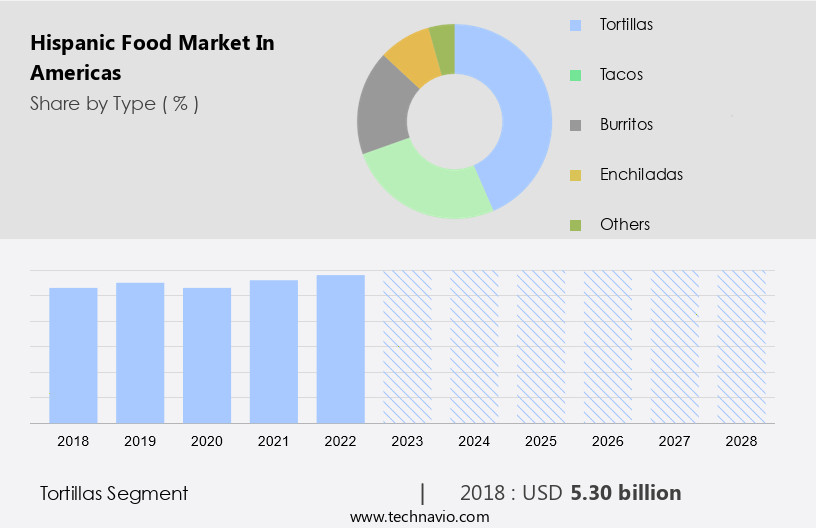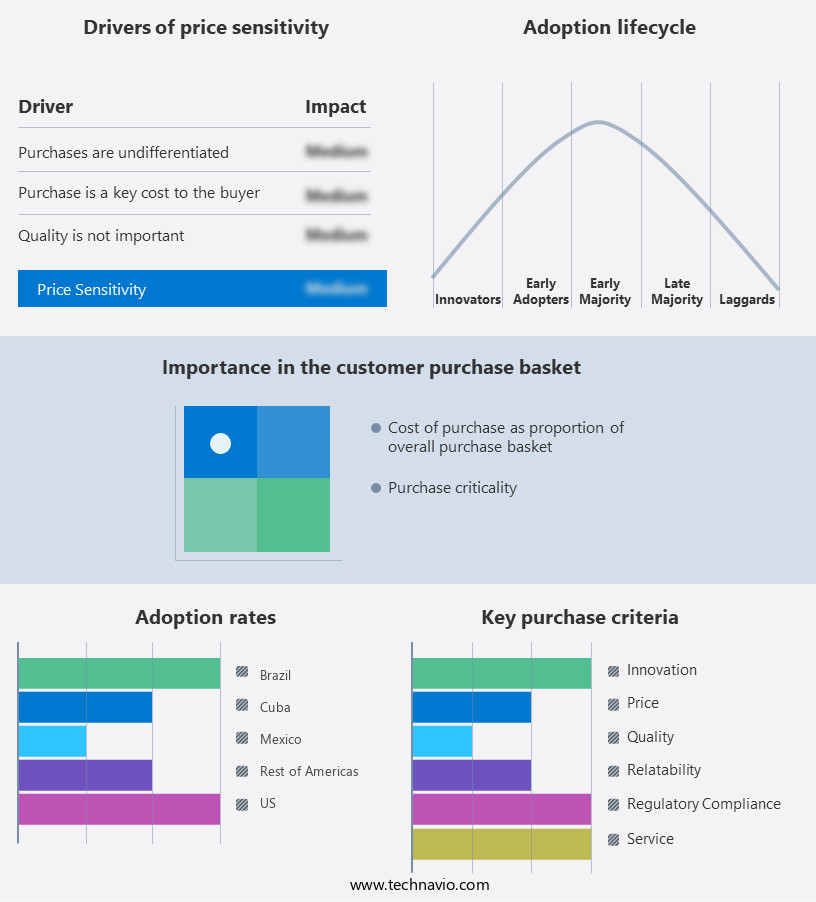Americas Hispanic Food Market Size 2024-2028
The Americas hispanic food market size is forecast to increase by USD 7.8 billion billion at a CAGR of 4.9% between 2023 and 2028.
- The Hispanic food market In the United States is experiencing significant growth, driven by the increasing popularity of traditional dishes such as stew-like soups made with Red and Green chiles, as well as Spicy offerings featuring Guajillo and Pasilla chiles. This trend aligns with the cultural significance of food as a representation of life's blessings and celebrations, particularly during holidays. These red and green chiles add depth and complexity to various dishes, particularly stew-like soups and sauces. Additionally, the convenience of ordering Mexican Street Food favorites like Elote and Mexican Street Corn through online portals and mobile apps continues to fuel market expansion. However, product recalls can pose challenges to market growth, emphasizing the importance of food safety and quality assurance. Overall, the Hispanic food market is poised for continued growth, fueled by changing consumer preferences and the enduring appeal of authentic, flavorful dishes.
What will be the size of the Americas Hispanic Food Market during the forecast period?

Request Free Sample
- The Hispanic food market in the United States is a rich and diverse tapestry of flavors, colors, and traditions. This market is characterized by its use of bold spices, fresh produce, and distinctive ingredients. Two of the most commonly used chiles in Hispanic cuisine are guajillo and pasilla. During holidays and special occasions, Hispanic food takes on an even greater significance as a symbol of life's blessings and celebrations. One popular holiday dish is elote, or Mexican street corn.
- Corn is grilled and smothered in a zesty mixture of sour cream, mayonnaise, lime juice, garlic, chili powder, and cotija cheese. The result is a delicious, spicy, and savory treat that embodies the vibrant flavors of Hispanic cuisine. Street food is another integral part of the Hispanic food market. Grilled chicken tacos, for example, are a staple of Mexican street food. These tacos are typically made with chicken thigh or breast, seasoned with chili powder and other spices, and served on flour tortillas. A refreshing corn-jicama salsa provides a cool contrast to the spicy chicken. Michelada, a popular Mexican beverage, is a must-try for those seeking a unique and flavorful drinking experience.
- Made with a variety of ingredients, including lime juice, tomato juice, chili powder, and beer, michelada is a spicy and savory beverage that is perfect for sipping on a sunny day. The Hispanic food market offers a wealth of opportunities for those seeking new and exciting flavors. From the bold and spicy to the refreshing and savory, there is something for every palate. Whether you're looking to add some excitement to your meals or simply want to explore new culinary traditions, the Hispanic food market is a delicious and vibrant world waiting to be discovered.
How is this market segmented and which is the largest segment?
The market research report provides comprehensive data (region-wise segment analysis), with forecasts and estimates in "USD billion" for the period 2024-2028, as well as historical data from 2018-2022 for the following segments.
- Type
- Tortillas
- Tacos
- Burritos
- Enchiladas
- Others
- Geography
By Type Insights
The tortillas segment is estimated to witness significant growth during the forecast period. The Hispanic Food Market In the Americas has seen significant growth, particularly In the segment for tortillas. This trend is driven by the increasing consumption of Hispanic foods in developed countries like the US, where per capita intake is on the rise. Taste preferences are evolving, leading to an increase in sales of flavored tortillas. To cater to this diversity, global companies are introducing new products.
For instance, while tortilla chips were initially limited to a few flavors, they now come in a variety, such as cinnamon, cheddar, and jalapeno. Small regional players are also capitalizing on this trend by offering creative and artisanal products that resonate with consumers' desire for authenticity. The tortillas segment holds a substantial share of the Hispanic Food Market In the Americas.

Get a glance at the market share of various segments Request Free Sample
The tortillas segment was valued at USD 5.30 billion in 2018 and showed a gradual increase during the forecast period.
Market Dynamics
Our researchers analyzed the data with 2023 as the base year, along with the key drivers, trends, and challenges. A holistic analysis of drivers will help companies refine their marketing strategies to gain a competitive advantage.
What are the key market drivers leading to the rise in adoption of Americas Hispanic Food Market?
- Changing lifestyles and rise in demand for healthy, convenient food is the key driver of the market. The global urban population reached 3.9 billion in 2020, representing a 56.2% share of the world's total population. This demographic shift, driven by urbanization, has led to an increase in disposable income and job opportunities. Consequently, there is a growing demand for convenient and easy-to-prepare food options, including Hispanic food. Hispanic cuisine offers numerous health benefits. For instance, tortillas, a staple ingredient, contribute sodium necessary for maintaining the body's water balance. Corn, a significant component of Hispanic dishes, is rich in vitamin B. Moreover, traditional meals include nutritious ingredients like tomatoes, squash, chia seeds, pumpkin, and cactus. Despite common misconceptions, Hispanic food can contribute to a balanced diet.
- The nutritional value of these foods may stem from the association of Hispanic cuisine with convenience and fast food. However, when prepared traditionally, these dishes offer numerous health benefits. Incorporating Hispanic foods into your diet can provide various health advantages. For example, tomatoes are rich in lycopene, a powerful antioxidant. Squash is an excellent source of fiber and vitamin C. Chia seeds offer omega-3 fatty acids and fiber. Pumpkin is rich in vitamin A and fiber. Cactus, a lesser-known ingredient, is rich in fiber and antioxidants. By embracing these staple ingredients, you can enhance your overall health and well-being.
What are the market trends shaping the Americas Hispanic Food Market?
- Growing popularity of food ordering through online portals and mobile apps is the upcoming trend In the market. Online food ordering systems offer numerous benefits for Hispanic food markets and takeaway restaurants In the US. Compared to traditional telephone orders, online platforms provide a more efficient ordering process with fewer communication errors. During peak hours, online orders ensure that orders are not lost due to engaged phone lines, enabling restaurants to better manage their workload. Moreover, online ordering systems offer valuable consumer feedback and insights, allowing restaurants to improve their offerings and enhance the customer experience. Consumers also tend to spend more when ordering online due to attractive digital menus, leading to increased order values. To expand their customer base, many Hispanic food markets and takeaway restaurants are adopting mobile app-based food ordering systems.
- These apps offer convenience and flexibility to consumers, enabling them to directly order meals for delivery or pick up. Additionally, online ordering systems provide access to a wider range of menu items, including insulin-sensitivity-friendly options such as rice, smoothies, puddings, jams, fiber-rich dishes, calcium-fortified meals, and omega-3 fat-rich options. By embracing online ordering systems, Hispanic food markets and takeaway restaurants can cater to the evolving needs and preferences of their customers while optimizing their operations.
What challenges does Americas Hispanic Food Market face during the growth?
- Product recalls is a key challenge affecting the market growth. Hispanic food markets In the Americas may encounter challenges due to food recalls, as demonstrated by the USDA's warning in 2020 regarding contaminated frozen Mexican food from Texas with potential plastic pieces. Consumers' health can be negatively impacted by ingesting these foreign objects, leading to health concerns such as choking. This, in turn, can result in decreased sales of Hispanic food products and subsequent recalls by various grocery and convenience stores In the US. The USDA advises consumers to refer to its website for a comprehensive list of recalled products and establishment numbers, including EST 5590, P5590, and EST, to ensure food safety.
- Hispanic food offers various nutritional benefits, making it a popular choice for many. For instance, chiles, such as jalapeños and Poblano, are rich in vitamins C and A. Vitamin C boosts the immune system, while Vitamin A promotes good vision and skin health. Capsaicin, a compound found in chiles, has been linked to reducing cholesterol levels, which is beneficial for cardiovascular health. Additionally, beans, a staple in Hispanic cuisine, are an excellent source of fiber and protein, aiding in managing Type 2 diabetes. Therefore, it is crucial to maintaIn the highest food safety standards to ensure consumers can enjoy these nutritional benefits without health risks.
Exclusive Americas Hispanic Food Market Customer Landscape
The market forecasting report includes the adoption lifecycle of the market, covering from the innovator's stage to the laggard's stage. It focuses on adoption rates in different regions based on penetration. Furthermore, the report also includes key purchase criteria and drivers of price sensitivity to help companies evaluate and develop their market growth analysis strategies.

Customer Landscape
Key Companies & Market Insights
Companies are implementing various strategies, such as strategic alliances, market forecast partnerships, mergers and acquisitions, geographical expansion, and product/service launches, to enhance their presence In the market.
The market research and growth report includes detailed analyses of the competitive landscape of the market and information about key companies, including:
- AmigoFoods
- B and G Foods Inc.
- Campbell Soup Co.
- Conagra Brands Inc.
- Corporativo Bimbo SA de CV
- El Patron
- Food Concepts International
- Garcia Foods
- General Mills Inc.
- Hormel Foods Corp.
- Juanitas Foods
- La Tortilla Factory
- MTY Food Group Inc.
- Ole Mexican Foods Inc.
- OTB Acquisition LLC
- Pappas Restaurants Inc.
- Patron Mexican Grill
- R.W. Garcia
- The Kraft Heinz Co.
- YUM Brands Inc.
Qualitative and quantitative analysis of companies has been conducted to help clients understand the wider business environment as well as the strengths and weaknesses of key market players. Data is qualitatively analyzed to categorize companies as pure play, category-focused, industry-focused, and diversified; it is quantitatively analyzed to categorize companies as dominant, leading, strong, tentative, and weak.
Research Analyst Overview
Hispanic food market is known for its vibrant and flavorful dishes, incorporating a rich palette of colors and spices. Red and green chiles, such as guajillo and pasilla, add a spicy kick to stew-like soups and holiday dishes, symbolizing life's blessings. Corn is a staple ingredient, transformed into elote, Mexican street corn, smothered in sour cream, mayonnaise, lime, garlic, and cotija cheese. Chili powder, soaking In the sun, infuses dishes with a smoky, earthy flavor. Street food is a significant part of the Hispanic food scene, with grilled chicken tacos, corn-jicama salsa, and flour tortillas. Black beans, a traditional meal, provide fiber and calcium, debunking misconceptions about unhealthy Hispanic foods.
Chicken thigh and breast are versatile proteins, used in easy chicken enchiladas, smothered in enchilada sauce, cream cheese, and salsa. The Hispanic food market offers a balance of nutrition, with vitamin C-rich tomatoes, squash, and vitamin A-packed chiles. Jalapeños and poblano peppers add capsaicin, beneficial for cardiovascular health and insulin sensitivity. Chia seeds, pumpkin, and cactus are nutrient-dense superfoods, offering omega-3 fats, vitamins, and fiber. Rice, smoothies, puddings, and jams are also part of the Hispanic food market, providing a variety of options for a balanced diet. Misconceptions about high cholesterol and type 2 diabetes can be addressed through the incorporation of these nutritious foods into daily meals.
|
Market Scope
|
|
Report Coverage
|
Details
|
|
Page number
|
136
|
|
Base year
|
2023
|
|
Historic period
|
2018-2022 |
|
Forecast period
|
2024-2028
|
|
Growth momentum & CAGR
|
Accelerate at a CAGR of 4.9%
|
|
Market growth 2024-2028
|
USD 7.8 billion
|
|
Market structure
|
Fragmented
|
|
YoY growth 2023-2024(%)
|
4.5
|
|
Competitive landscape
|
Leading Companies, Market Positioning of Companies, Competitive Strategies, and Industry Risks
|
Request Free Sample
What are the Key Data Covered in this Market Research Report?
- CAGR of the market during the forecast period
- Detailed information on factors that will drive the market growth and forecasting between 2024 and 2028
- Precise estimation of the size of the market and its contribution of the market in focus to the parent market
- Accurate predictions about upcoming market growth and trends and changes in consumer behaviour
- Growth of the market across Americas
- Thorough analysis of the market's competitive landscape and detailed information about companies
- Comprehensive analysis of factors that will challenge the growth of market companies
We can help! Our analysts can customize this market research report to meet your requirements Get in touch







![]() Get the report (PDF) sent to your email within minutes.
Get the report (PDF) sent to your email within minutes.
Complimentary full Excel data with your report purchase.